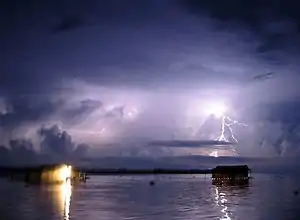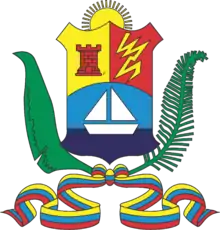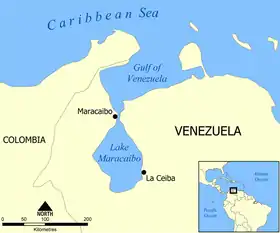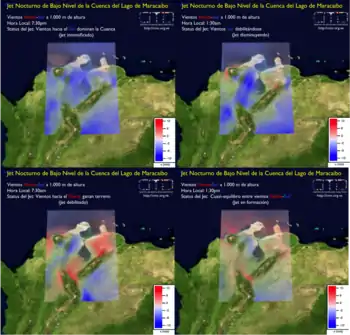Catatumbo lightning
Catatumbo lightning (Spanish: Relámpago del Catatumbo)[1] is an atmospheric phenomenon that occurs over the mouth of the Catatumbo River where it empties into Lake Maracaibo in Venezuela. It originates from a mass of storm clouds at an altitude of more than 1 km, and occurs during 140 to 160 nights a year, 10 hours per day, and up to 280 times per hour.[2] It occurs over and around Lake Maracaibo, typically over a bog area formed where the Catatumbo River flows into the lake.[3]

The lightning changes its frequency throughout the year, and it is different from year to year. For example, it ceased from January to March 2010, apparently due to drought, leading to speculation that it might have been extinguished permanently.[4][5][6]
Historical references


Prussian naturalist and explorer Alexander von Humboldt described the lightning in 1826.[7] Italian geographer Agustin Codazzi described it in 1841 as "like a continuous lightning, and its position such that, located almost on the meridian of the mouth of the lake, it directs the navigators as a lighthouse."[8]
The phenomenon is depicted on the flag and coat of arms of the state of Zulia, which also contains Lake Maracaibo, and is mentioned in the state's anthem. The phenomenon has been known for centuries as the "Lighthouse of Maracaibo", since it is visible for miles around Lake Maracaibo.[9]
Some authors have misinterpreted a reference to a glow in the night sky in Lope de Vega's description in his epic La Dragontea of the attack against San Juan de Puerto Rico by Sir Francis Drake as an early literary allusion to the lightning (since in another verse the poet does mention Maracaibo), but it was actually a reference to the glow produced by burning ships during the battle.[10]
Location and mechanism

Catatumbo lightning usually develops between 8°30′N 71°0′W and 9°45′N 73°0′W. The storms are thought to be the result of winds blowing across Lake Maracaibo and the surrounding swampy plains. These air masses meet the high mountain ridges of the Andes, the Perijá Mountains (3,750 m), and Mérida's Cordillera, enclosing the plain from three sides. The heat and moisture collected across the plains create electrical charges and, as the air masses are destabilized by the mountain ridges, result in thunderstorm activity.[4] The phenomenon is characterized by almost continuous lightning, mostly within the clouds. The lightning produces a great quantity of ozone though its instability makes it unlikely that it has any effect on the ozonosphere.[11]
Scientific studies
Between 1966 and 1970, Russian researcher Andrei Zavrotsky investigated the area three times, with assistance from the University of the Andes. He concluded that the lightning has several epicenters in the marshes of Juan Manuel de Aguas National Park, Claras Aguas Negras, and west Lake Maracaibo. In 1991 he suggested that the phenomenon occurred due to cold and warm air currents meeting around the area. The study also speculated that an isolated cause for the lightning might be the presence of uranium in the bedrock.[12]
Between 1997 and 2000, a series of four studies proposed that the methane produced by the swamps and the massive oil deposits in the area were a major cause of the phenomenon.[13] The methane model is based on the symmetry properties of methane. Other studies have indicated that this model is contradicted by the observed behaviour of the lightning, as it would predict that there would be more lightning in the dry season (January–February), and less in the wet season (April–May and September–October).[14][15]
A team from the Universidad del Zulia has investigated the impact of different atmospheric variables on Catatumbo lightning's daily, seasonal and year-to-year variability, finding relationships with the Inter-Tropical Convergence Zone, El Niño–Southern Oscillation, the Caribbean Low-Level Jet, and the local winds and convective available potential energy.[16][17][18][19] Using satellite data, two groups of researchers have provided analyses of the lightning's location, timing and number of discharges per square kilometer.[20][21][14]
Predictability

A 2016 study showed that it is possible to forecast lightning in the Lake Maracaibo basin up to a few months in advance, based in the variability of the Lake Maracaibo Low-Level Jet and its interactions with predictable climate modes like the ENSO and the Caribbean Low-Level Jet. The study also showed that the forecast accuracy is significantly higher when an index based on a combination of winds and convective available potential energy is used. The index seems to capture well the compound effect of multiple climate drivers.[22]
See also
References
- "Fogonazos: Catatumbo, the everlasting storm". Fogonazos.blogspot.com. Retrieved 2010-07-27.
- citation needed
- "Catatumbo Lightning – Congo". Real Travel. Archived from the original on 2011-07-16. Retrieved 2010-07-27.
- "Catatumbo Lightning". Wondermondo. 2010-08-21.
- Carroll, Rory (5 March 2010). "Drought extinguishes Venezuela's lightning phenomenon". The Guardian. Retrieved 3 January 2013.
- Guttman, Matt; Robert Rudman. "Venezuela's Mysterious Catatumbo Lightning Phenomenon Vanishes for Months, Then Reappears". ABC News. Retrieved 3 January 2013.
- La distancia de más de 40 leguas a que se distingue la luz ha hecho creer que podría ser el efecto de una tempestad o de explosiones eléctricas que tuviesen lugar diariamente en una garganta de montañas y aun se asegura que se oye el ruido del trueno cuando se aproxima uno al farol.
- Alexander von Humboldt and Aimé Bonpland, Viage a las Regiones Equinocciales del Nuevo Continente, volume 2, book V, chapter XVI, page 390, note, Casa de Rosa, Paris, 1826; Ediciones del Ministerio de Educación, 2a. ed., Caracas, 1956.
- Es como un relámpago continuado y su posición tal que, situado casi en el meridiano de la boca del lago de Maracaibo, dirige a los navegantes como un faro.
- Codazzi Agustín, Resumen de la Geografía de Venezuela, Fournier, Paris, 1841, pp. 20, 464 y 466.
- "Lightning Up, 4 Feb 2010". Blogs.ngm.com. 2002-10-17. doi:10.1371/journal.pbio.0040050. PMC 1363710. Archived from the original on 2012-01-29. Retrieved 2013-02-08. Cite journal requires
|journal=(help)CS1 maint: bot: original URL status unknown (link) - Dislates y Disparates sobre el Relámpago del Catatumbo: La expedición de Drake, de 1595, Ángel Vicente Muñoz García, Centro de Modelado Científico, Maracaibo, agosto 2016.
- ¿Relámpagos del Catatumbo regeneran la capa de ozono? Archived 2016-03-05 at the Wayback Machine. Agencia de noticias de la Universidad del Zulia.
- "Una vida consagrada a los números" (PDF).
- "Phenomena – A science salon hosted by National Geographic Magazine". Blogs.ngm.com. 2002-10-17. doi:10.1371/journal.pbio.0040050. PMC 1363710. Archived from the original on 2012-01-29. Retrieved 2013-02-08. Cite journal requires
|journal=(help)CS1 maint: bot: original URL status unknown (link) - Bürgesser, R. E.; Nicora, M. G.; Ávila, E. E. (2012). "Characterization of the lightning activity of "Relámpago del Catatumbo". Journal of Atmospheric and Solar-Terrestrial Physics. 77: 241–247. Bibcode:2012JASTP..77..241B. doi:10.1016/j.jastp.2012.01.013.
- Muñoz, Á.G.; Díaz-Lobatón, J.; Chourio, X.; Stock, J. (2016). "Seasonal prediction of lightning activity in North Western Venezuela: Large-scale versus local drivers". Atmospheric Research. 172–173: 147–162. Bibcode:2016AtmRe.172..147M. doi:10.1016/j.atmosres.2015.12.018.
- Muñoz, Á.G., Díaz-Lobatón, J., 2011: "The Catatumbo Lightnings: A review", Memoirs of the XIV International Conference on Atmospheric Electricity. Brazil.
- Torrealba, E.; Amador, J. (2010). "La corriente en chorro de bajo nivel sobre los Llanos Venezolanos de Sur América". Revista de Climatología. 10: 1–20.
- Muñoz, Á.G., Díaz-Lobatón, J., 2012: Los Relámpagos del Catatumbo y el Flujo Energético Medio en la Cuenca del Lago de Maracaibo. Reporte público CMC-GEO-DDI-02-2011. Centro de Modelado Científico. Universidad del Zulia. 12 p. En http://cmc.org.ve/portal/archivo.php?archivo=241
- Muñoz, Á.G., Núñez, A., Chourio, X., Díaz-Lobatón, J., Márquez, R., Moretto, P., Juárez, M., Casanova, V., Quintero, A., Zurita, D., Colmenares, V., Vargas, L., Salcedo, M.L., Padrón, R., Contreras, L., Parra, H., Vaughan, C., Smith, D., 2015: Reporte Final de la Expedición Catatumbo: Abril 2015. Reporte Público CMC-01-2015. Centro de Modelado Científico (CMC). Universidad del Zulia. 20 p. doi:10.13140/RG.2.1.1351.0566
- Albrecht, R., et al., 2011. The 13 years of TRMM Lightning Imaging Sensor: from individual flash characteristics to decadal tendencies. XIV Int. Conf. Atmos. Elec., Rio de Janeiro, Brazil.
- Albrecht, R. I.; Goodman, S. J.; Buechler, D. E.; Blakeslee, R. J.; Christian, H. J. (2016). "Where are the lightning hotspots on Earth?". Bulletin of the American Meteorological Society. 97 (11): 2051–2068. Bibcode:2016BAMS...97.2051A. doi:10.1175/BAMS-D-14-00193.1.
- Muñoz, Á.G.; Díaz-Lobatón, J.; Chourio, X.; Stock, J. (2016). "Seasonal prediction of lightning activity in Northwestern Venezuela: Large-scale versus local drivers". Atmospheric Research. 172–173: 147–162. Bibcode:2016AtmRe.172..147M. doi:10.1016/j.atmosres.2015.12.018.
External links
- World's first seasonal lightning forecast
- Storm Chaser George Kourounis Investigates the Catatumbo Lightning Phenomenon
- An Everlasting Lightning Storm, article at Slate.com
- WWLLN World Wide Lightning Location Network
